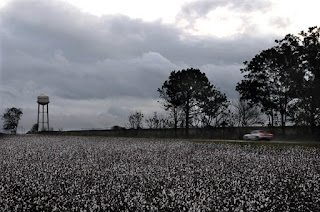Harvesters crisscrossed
the brown, defoliated cotton fields. Boll buggies and module builders churned
away.
“Harvesting was in full throttle,”
field scout Carlos Silva says.
Then cloudy skies
darkened and the clouds burst, dumping rain onto the fields. Rain puddled up,
leaving the bumpy dirt roads muddy.
Suddenly, Mother Nature brought harvesting to a temporary halt late last
week.
This is the first rain
that was substantial,” Carlos adds.
 |
| Rain storms the past few days slowed the cotton harvest. |
Yes,
farm communities in the San Joaquin County received more than .60-inches of
rain Thursday through Sunday, with the heaviest coming on Friday. That meant
stop and go harvest operations for several days.
“If it doesn’t rain too much it shouldn’t be a
problem. It can help clean up the cotton,” Carlos points out. In fact, a little shower from nature can wash
away dust, dirt and any sticky honeydew on the lint. A cleaner fiber is good
when it’s time to be processed at the cotton gin.
 |
| A boll buggy empties picked cottton into a module builder. |
On
the other hand, the rain can impact color and fiber quality, which will lessen
the value of the cotton. Storms also can cause bolls to drop to the ground.
Growers need to make
sure the damp cotton has enough time to dry up to avoid moisture build up.
There’s nothing like some sunshine and a little wind todo the trick.
 |
| Cotton modules line the border of a field. |
With Halloween today,
we can safely say cotton picking is definitely going into November. “I’m still
seeing a lot of fields waiting to be harvested,” Carlos says. He anticipates
the harvest to pretty much wind down around mid-November.
Right now, ginning
operations are gearing up. While some ginsare operating, Carlos notes that
other “gins haven’t even opened.” Theywant to make sure
the inventory, or cotton modules, are lined up and ready for processing before the
plants are fired up.
Meanwhile, Carlos says alfalfa,
growers are starting to wrap up for the season. Some are disking fields while
other growers are deciding whether it’s worth the time and money to coax more
growth from their crop and try for one more harvest.










